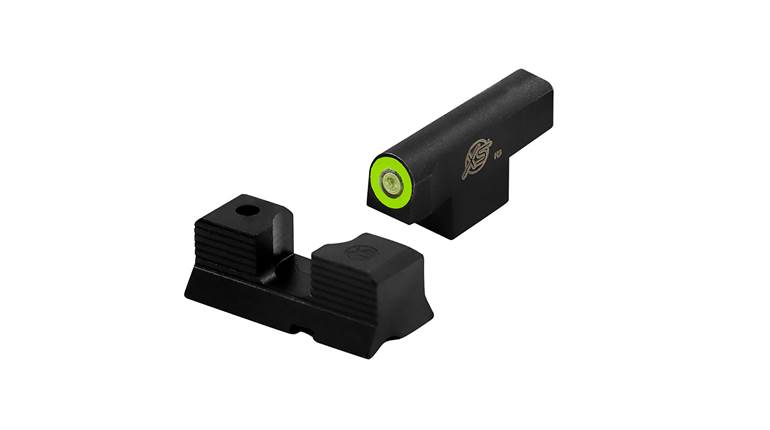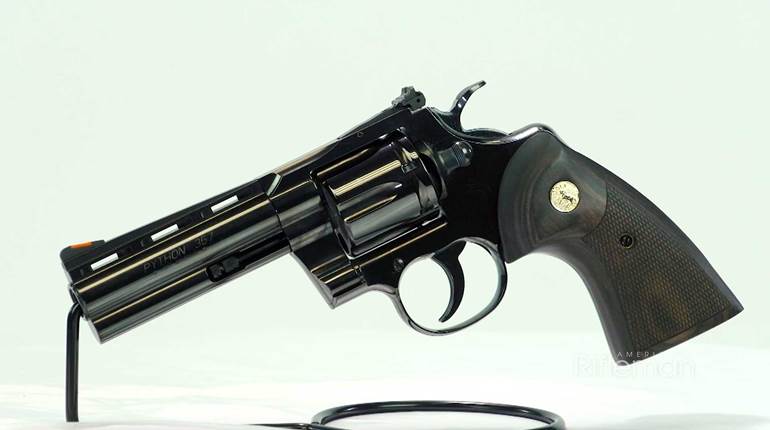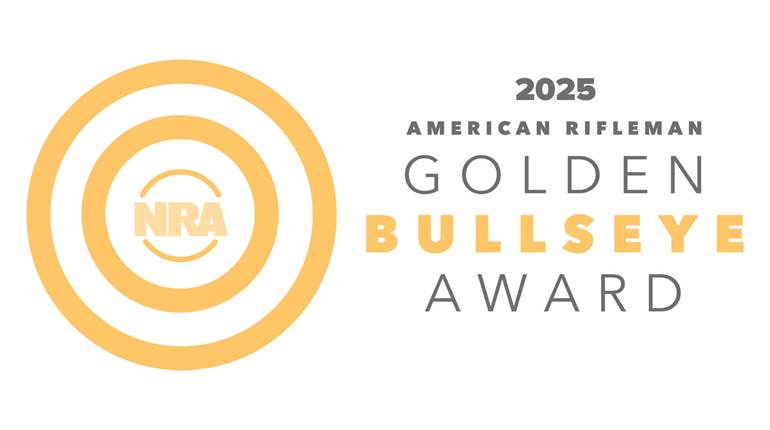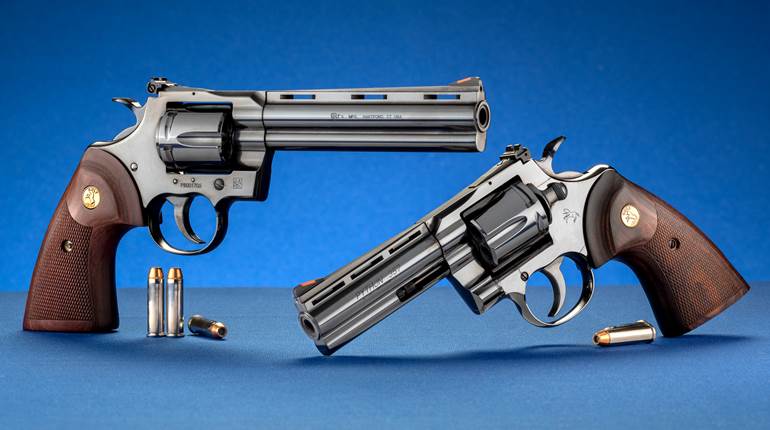
My previous posts on the Trython seemed to have stirred up reader interest. The first one dealt with what I guess would have to be called the Python phenomenon. In it, I briefly discussed the history of this great Colt revolver and how it stacked up against the competition. That part of it is important, because as rare and desirable as Pythons certainly are, that all started as a matter of in-hand performance. At the start, the Python earned a reputation for accuracy, as well as balance and trigger action. They were designed to be shooters and not artifacts. A by-product of the legendary reputation is simply the fact that those that have one usually just smile and shoot—user grade Pythons aren't often seen for sale. The new or lightly used guns are easy to find at internet auctions or at high-end gun shows. Their prices are out of sight. 
This situation led to the procedures described in my most recent post—Enter The Trython. I had re-discovered an almost forgotten process whereby a Colt Trooper could be lightly modified by adding welded material to the top front corner of the frame and grinding it down to Python shape. Screw in a Python barrel and you have a gun that looks like a Python, feels like a Python, fires like a Python, but is not a Python. I've dubbed it the Trython. The two Trythons pictured in the last blog were done up with special grips and unusual barrel lengths and are really slick. There were reader and in-person comments to the effect that producing a Trython might not be really cost-effective. That depends on what you want to do, and we need to go into a little more detail to show what I mean before we go to the range and shoot the two that I have.

First, you can't do this without two essential parts, a Python barrel and a Trooper revolver. I used 8-inch .38 Spl. barrels from Numrich (about $138, plus shipping). They are new and work perfectly. Any other Python barrel in sound condition of any length will also work. If you happen to have an older Trooper, you are in business. Since I wanted top-notch guns for this project, I picked up two really nice guns on on-line auction for an average price of about a grand. You may be able to do a great deal better with patience and bargaining. It is a bit of false economy to use a near-junker for the Trython, because the project gunsmith may have to spend costly time fixing anything wrong. My 5-inch Trython came from a Trooper that needed no action work at all. 
If you have a Python barrel that you want to go on your modified Trooper frame, the 'smith has nothing to do but the welding and shaping thereof, installing the barrel and probably bluing everything. The project would be relatively simple and I think (with a purchased barrel and gun), you'd be out the door for way under two grand. Costs start to go up when you want to shorten the barrel, because that means gunsmith effort in properly shaping the muzzle end of the barrel, working the front sight ramp and a little welding to make the ventilated rib look proper. The result is a Trython and I have no real feel for what it's worth. But this is obviously true if you view the Trython as a traditionally-styled Colt revolver to be fired and used heavily—it will cost about a third to half as much as buying a comparable Python revolver.
It comes down to a question of how badly you want a shooting specimen of the classic old-time Colt product. If you need an up-to-date .357 Mag. revolver in any barrel length, style, weight or capacity, the good folks at Ruger, Taurus or Smith & Wesson can doubtless find something in their varied catalogs that will fill the bill. I don't pretend to say that you need to rush out tomorrow and start buying the necessary parts—unless you want to be the first kid in your club who shoots Colt as a matter of course.
Trythons are not a matter of necessity; they are a serious shooter's luxury.
I've gone on at length about shooting these things, so it is time to go to the range and see what they will do. Let's look at the 3-inch Trython first. As noted in the first installment of this series, Colt made several small batches of 3-inch Pythons and there was a well-executed series of 3-inchers made after market in California. The general idea was to create a concealable gun with a more Python-like, muzzle heavy feel than the factory-standard 2 ½-inch. Not only did the resulting gun achieve the balance goal, it also turned out to be more visually appealing. My 3-inch Trython nicely replicates the original guns. I was able to lay hands on an original 2 ½ inch for a brief non-firing comparison. With the addition of a mere ½-inch of barrel length, the revolver looks great—and hefts even better.


In my opinion, almost all modern DA/SA revolvers need custom grips if you are going to shoot them often, but the medium Colt frame is pretty close to being that rule's exception. In a concession to the gun's earliest origins, I used a pair of hard-rubber grips from an early Colt Army Special. They were rounded at both toe and heal of the butt in order to match the lightly modified frame. Finally, a new Pachmayr grip adapter behind the trigger guard cut down on the Colt's tendency to crack your knuckles when firing hot loads. Since this version of the Trython was made for close- range defensive work, my gunsmith installed an X/S Big Dot front sight and left the plain black rear sight alone.
range defensive work, my gunsmith installed an X/S Big Dot front sight and left the plain black rear sight alone.
This is a pretty hefty piece of ordnance for concealed carry, but once you get the gun out of whatever hidey-hole you carry it in, you have a great defensive arm in your fist. The balance is forward and the weight of the gun tends to soak up recoil. Shooting closely spaced fast pairs with some hot .38 Spl. ammo at seven yards is easy and even high-velocity .357s are possible. When you go to the heavy-bullet .357 loads—Winchester Ranger SXT 180-gr.—well, you get recoil that stays with you for a while. This gun was put together by gunsmith Terry Tussey, who is one of the few revolver guys who can do anything with the complicated and challenging Colt action. The Trooper I provided him required some attention and got it. The trigger pull is a bit lighter than standard, but very smooth all the way through that long, sweeping arc.
I happen to be one of those characters who really like modern DA/SA revolvers with 5-inch barrels. I once saw a GunBroker.com offer of a 5-inch Python, honestly confessing the gun's non-factory origins. I believe the gun came from the hot bed of revolver modification (Sacramento, Calif.) in the 70s, but it really caught my fancy. When I got into this Trython business, it was a foregone conclusion that one of them would be a 5-incher. It was assembled in the manner we have already discussed, with a Trooper frame, Python barrel, etc. This is a big revolver and somewhat heavy, well suited for uniformed police use. Since you would have to look hard to find a modern cop with a revolver, I would also see the gun as good equipment for the outdoorsman. It is a big, heavy handgun that came with an action that was nearly new and required no modification.
Compared with the 3-inch Trython, the 5-inch has a longer sight radius and is obviously heavier. It is well-suited for engaging targets at range. Most commonly, I would cock the hammer for a long shot, using the single action aspect of the trigger system. On this Trython, there is a very nice clean trigger break with about 2 ½ pounds of pressure. Depending on the load, there is plenty of recoil, but the Colt standard grips do their job extremely well. The grip panels I used were original Python Type I walnut grips, with checkering running all the way to the top. Many shooters prefer the shape of these grips, not realizing that they follow the curve of the frame's backstrap. They contribute heavily to the 5-inch Trython's excellent in hand performance.
At the range, I fired both guns in the Ransom Rest, as well as by hand. In hand I used up several partial boxes of .38 Spl. and .357 Mag. ammo in the usual informal shooting. Everything about this aspect of the shoot was OK and I came away impressed. In the Ransom Rest (the handgunner's lie detector) I went through three different kinds of ammunition, shooting five consecutive five-shot groups with each gun. I suspected that the 5-inch would be the more accurate of the two. It averaged just under the 1 ½ mark at 1.47”, center spread. The more compact 3-inch Colt averaged only slightly more at 1.59” and experience tells me that if I repeated the test tomorrow, the guns might swap places. I am convinced that a wider range of ammo would reveal even greater accuracy.
So that's what I can tell you about my Trython experiment. If I have left you somehow puzzled about what I was doing, why I was doing it or any other aspect of the tortuous trail of the Trython, let's have your comments. It was a lot of time and effort, but boy, did I have fun.
Additional Reading:
Wiley Clapp: Enter the Trython
Wiley Clapp: This Python Business





































